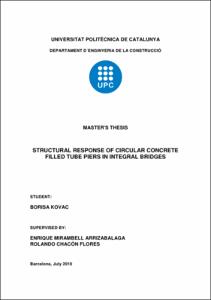Mostra el registre d'ítem simple
Structural response of circular concrete filled tube piers in integral bridges
| dc.contributor | Mirambell Arrizabalaga, Enrique |
| dc.contributor | Chacón Flores, Rolando Antonio |
| dc.contributor.author | Kovac, Borisa |
| dc.contributor.other | Universitat Politècnica de Catalunya. Departament d'Enginyeria de la Construcció |
| dc.date.accessioned | 2011-06-29T11:46:22Z |
| dc.date.available | 2011-06-29T11:46:22Z |
| dc.date.issued | 2010-07-10 |
| dc.identifier.uri | http://hdl.handle.net/2099.1/12352 |
| dc.description.abstract | Nowadays most of the bridges are designed with movable joints and bearings. They are used to allow for bridge deck displacements produced by: expansion and contraction of the bridge deck due to temperature changes, breaking or accelerating forces of vehicles and by long term changes of concrete such as creeping and shrinking. Joints and bearings are susceptible to durability problems and require maintenance and replacements. In order to reduce the maintenance costs and to lower the initial costs of construction, integral bridges - bridges without expansion joints and bearings - are used. In the case of integral bridges, bridge abutments and piers must be designed to be flexible enough to allow necessary deck displacements without reaching their ultimate bearing capacity and instability. The aim of this master thesis is to conduct a research on structural response of circular CFT (concrete filled tube) composite columns used as intermediate piers in integral bridges subjected to axial forces and bending moments caused by bridge weight and deck displacements respectively. The analysis is performed by finite element method using the software package Abaqus. A three dimensional model is defined using solid elements for both materials and paying special attention to the steel to concrete contact. Nonlinear behaviour of steel and concrete is taken into account. The confining effect of the concrete is also considered. Variations are done in ratio of steel and concrete used in the piers and also in N/Nu ratio for the equivalent bending moments. The finite element model is verified by comparing the results of numerical analysis with the results obtained by EN1994-1-1 and by other research studies on this subject. The results of the analysis are used to make conclusions and are compared to Eurocode design codes. |
| dc.language.iso | eng |
| dc.publisher | Universitat Politècnica de Catalunya |
| dc.rights | Attribution-NonCommercial-NoDerivs 3.0 Spain |
| dc.rights.uri | http://creativecommons.org/licenses/by-nc-nd/3.0/es/ |
| dc.subject | Àrees temàtiques de la UPC::Enginyeria civil |
| dc.subject | Àrees temàtiques de la UPC::Enginyeria civil::Materials i estructures::Materials i estructures de formigó |
| dc.subject.lcsh | Concrete construction |
| dc.subject.lcsh | Concrete bridges |
| dc.subject.lcsh | Structures |
| dc.subject.lcsh | Bridges -- Foundations and piers |
| dc.title | Structural response of circular concrete filled tube piers in integral bridges |
| dc.type | Master thesis |
| dc.subject.lemac | Construccions de formigó |
| dc.subject.lemac | Ponts de formigó |
| dc.subject.lemac | Estructures mixtes |
| dc.subject.lemac | Ponts -- Fonaments i pilastres |
| dc.rights.access | Open Access |
| dc.audience.educationlevel | Màster |
| dc.audience.mediator | Escola Tècnica Superior d'Enginyers de Camins, Canals i Ports de Barcelona |
| dc.audience.degree | MÀSTER UNIVERSITARI EN ENGINYERIA ESTRUCTURAL I DE LA CONSTRUCCIÓ (Pla 2009) |


